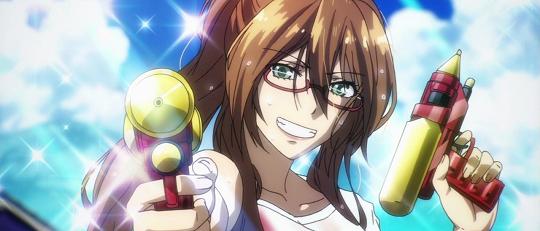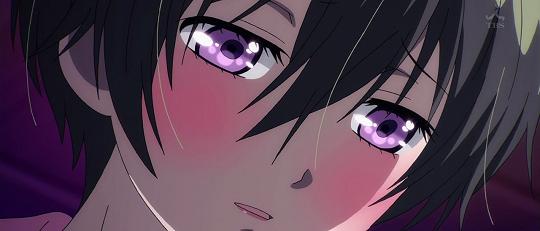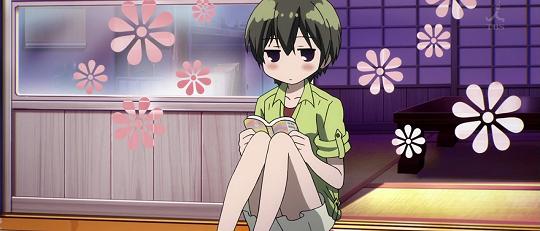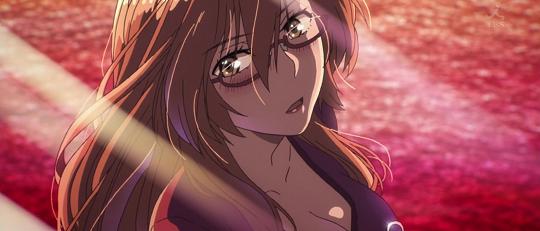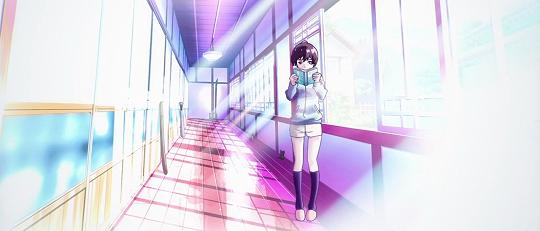I didn’t even really consider that “dormitory comedy” was an actual sub-genre until I drew a line connecting Love Hina, Sakurasou no Pet na Kanojo and now, Bokura wa Minna Kawaisou (We are all from Dormitory Kawai / The Kawai Complex guide to Manors and Hostel Behaviour). In theory I suppose you could include less noteworthy series such as Sekirei but that firmly placed itself on the “harem” side of things which I guess Love Hina occupies as well.. But that would mess up a perfectly good grouping of decent comedies set in dormitories.
Despite its reverence towards introversion, Kawaisou is definitely a comedy as if the swathes of stylised on-screen text and exaggerated expressions didn’t already give it away. The benefit of being set in a dormitory, and not just one for school children, is that it smooshes together a lot of different characters who wouldn’t otherwise associate. It’s the inverse of the “box of scorpions” setup that horror movies use to manufacture drama and mystery; with comedies though, as long as you get the mix of personalities right, comedy will just fall out of it.
By and large, Kawaisou consistently achieves this which goes a long way to papering over the romantic subplot between oddball wrangler Kazunari Usa, Kawai dormitory newbie, and Ritsu Kawai, bibliophile and perennial winner of “Most Sparkling Eyes”. By the end of the second episode all of the dormitory’s occupants have been introduced: there’s Shirosaki, a reluctant writer and fervent masochist, Mayumi a working woman (doing what is never revealed) and serial lush, Sayaka a demon in human form, and Sumiko the elderly matron and caretaker.
From there the series follows a largely episodic structure with only certain events carrying over such as an old middle-school friend of Kazunari’s or a wide-eyed primary school child who, against all odds, becomes friends with Shirosaki. Subplots such as the budding high-school romance go at a glacial pace, like waiting for a ship to come into port - the outcome is set but the wait and expectation is excruciating. In context it makes sense. Ritsu after all is, kind of like Read or Die’s Yomiko Readman, oblivious to just about everything else when absorbed in a book, and that includes Kazunari’s teenage blatherings.
Other stories dig into both Mayumi and Sayaka’s characters a little more. The former describes herself as having “bad luck” with men, and the latter (who looks like an older version of Ao Haru Ride’s Yuuri) tirelessly manipulates men, both of their narratives focus on them gaining some measure of self-respect in order to overcome their issues. This is never stated explicitly and neither does the series bludgeon you with its morals but it demonstrates a deft touch with character drama that is completely opposed to the garish, overripe visuals and amplified expressions.
It’s no surprise that the director also helmed two of Aoi Bungaku’s episodes, the similar combination of detail and saturated colour usage here perfectly captures the long school summer that the majority of the series is set in. A time when the sunsets are scarlet and the days are ocean blue with the adventures you have all the colours in between. Scenes such as when the group play with bubbles in the dormitory grounds are gorgeous, and a fine accompaniment to the furtive, glittering looks that most of the females flash at one time or another.
All of that only works though because of the good natured style of its storytelling. There is a kind of timeless quality to each individual story, matched by period costumes that make an appearance halfway through; if you took away the cellphones and rewound the clock thirty years, the stories would still work. That’s odd to say when Shirosaki, Kazunari’s roommate, is a self professed masochist and an episode prominently features a neighbourhood molester; but Kawaisou lacks the caustic misanthropy that some series wallow in and is largely bereft of the lurid obsession with the female form.
So Shirosaki may well be a pervert and a masochist, however the only time we see him is when he’s exercising his crafty side, making Rube Goldberg-esque contraptions or putting together the apparatus for the aforementioned bubbles. This means when the pre-teen girl befriends him, it doesn’t have the squick factor one might imagine. That’s not to say the series is naive, that’s left to Ritsu and Kazunari, and nor is it a rose-tinted view of the world, just generally optimistic rather than the opposite.
The question remains then as to whether the series works as a comedy. It may have the dubious “violent retribution for accidental infringement” tag on AniDB but this only constitutes a very small part to Kawaisou’s charm. A lot of the humour happens when the group gather for dinner, or getting together and relaxing in the evening which means it’s less slapstick and more verbal. For the most part it works, enough to elicit a quick chuckle but rarely anything more. The series is fundamentally very safe, relying on established personality types and story hooks, but being safe isn’t a negative here when there is a huge amount of accomplished light humour to enjoy.


